

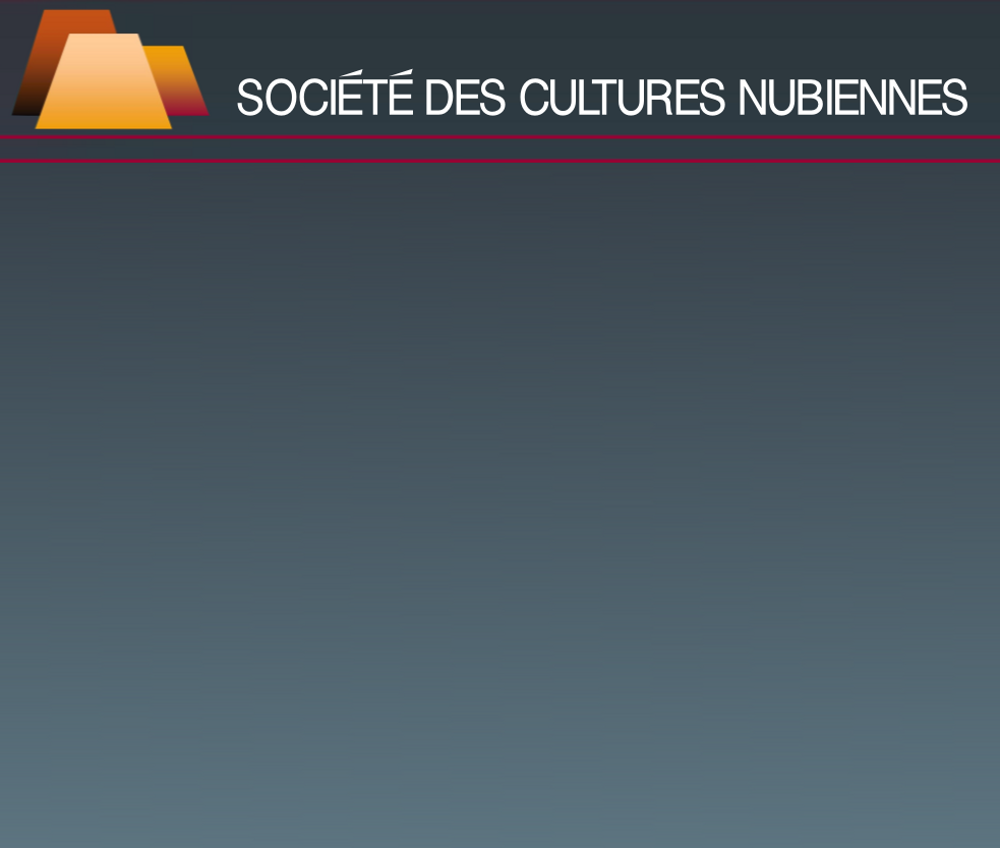
|
DJEBEL BARKAL (right bank of the Nile)
The Napatan dynasty was discovered at the beginning of the XX Century by the American George Andrew Reisner when he surveyed the area located downriver from the 4th Cataract. He uncovered the sites at Jebel Barkal, el-Kurru, Nuri and Sanam. In the Egyptian texts of the XVIII Dynasty, the name of Napata appears for the first time. Today it is used to designate the area of Jebel Barkal as well as a historical sequence including the sovereigns that made up the Egyptian XXV Dynasty and its successors (IX-IV Century BC)
The name of Jebel Barkal is associated with a tabular mountain 97 m high, called 'pure mountain' or 'holy mountain'. It has the form of an asymmetrical dome flanked on its north-west side of a rocky pinnacle that stands proud of the rest of the massif. The site is being studied by Tim Kendall, at that time of the Museum of Fine Arts of Boston, and by Alessandro Roccati of the University of la Sapienza at Rome, and includes religious, palatial and funerary remains. The Napatans attributed to the pinnacle several symbolic meanings. Through its ophidian form (of a raised cobra), it is associated with the feminine forms of the demiurge corresponding to the goddesses Hathor, Mut and Tefnut. It protects the sovereign and confirms him in his royal role. Through a play of light, especially at sunset, this pinnacle, seen from the south-east recalls the cap crown of the Kushite kings and according to the viewpoint, a person wearing the crown of Upper Egypt. During the 1820s, the villagers claimed that the natural rock face was in fact the remains of a statue. In 1941, visitors saw on the summit of the 'crown' the traces of royal names. In 1986, with the help of the alpinist Paul Duval, Timothy Kendall undertook the scaling of the rock face so as to study the inscriptions and the manner in which they have been carried out. This 'sporty' first of the world of archaeology allowed the reading of the names of Taharqo and Nastasen engraved on a panel. This panel was once covered in gold leaf, and when hit by the rays of the rising sun, it enhanced the symbolical significance of the cobra. On the south-east side of Jebel Barkal the great temple of Amun of Napata adjoins that of Amun of Thebes. To the north of these two sanctuaries one notices, against the face of the mountain, the remains of temples dedicated to the chthonian forms of Amun, Osiris and of the dead kings. On the west side, small buildings dedicated to the granddaughters of the god shelter a speos (a rock cut sanctuary within the mountain) called 'temple of the birth'. Timothy Kendall has found fragments of stars on a blue background, allowing us to guess that there was another speos under the stone pinnacle. To the south-east of the temples of Amun, the remains of the Palace of king Natakamani (20 BC -15 AD) suggest an area of cult worship that is still to be discovered. To the west of the 'pure' mountain, two groups of pyramids catch the visitors' attention. |
 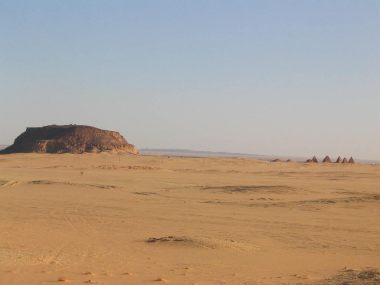 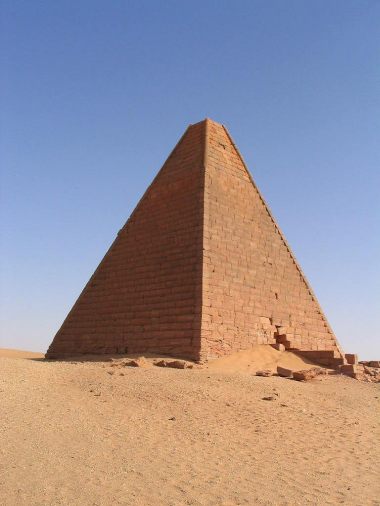 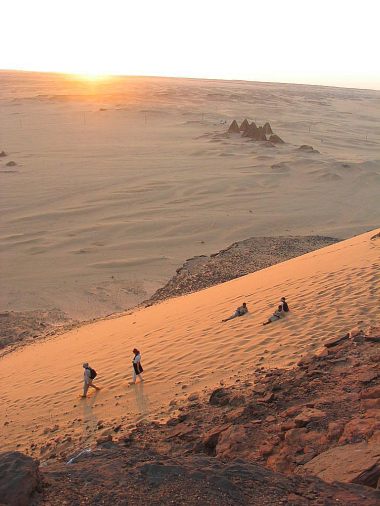 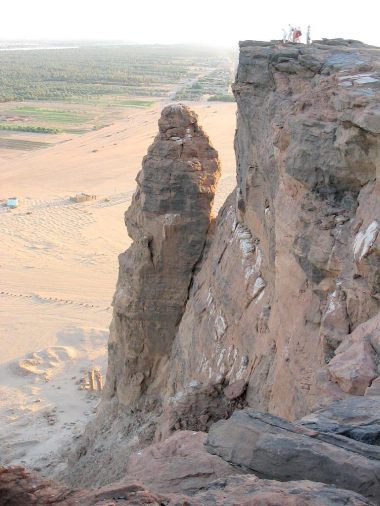 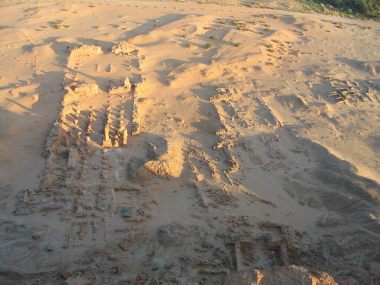 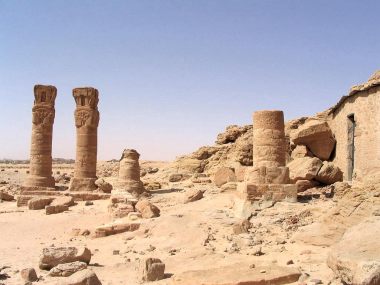 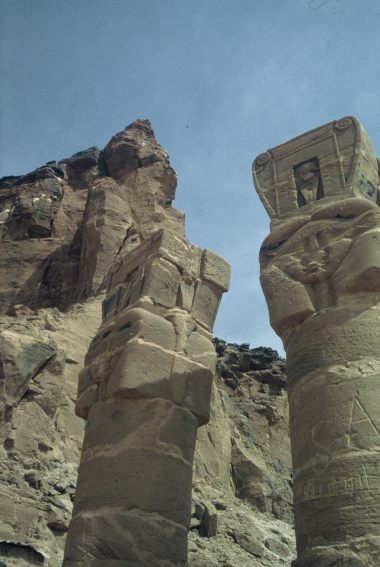 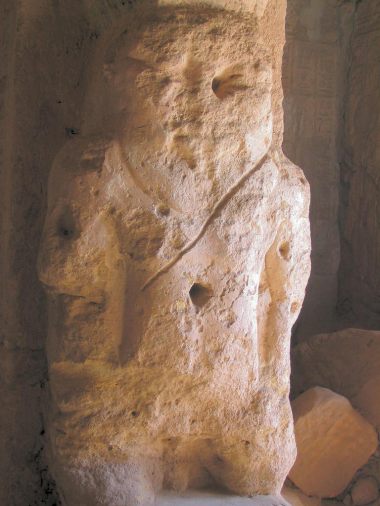 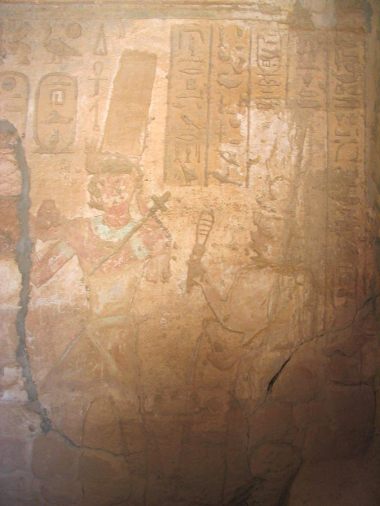 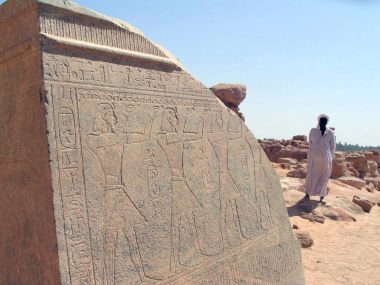 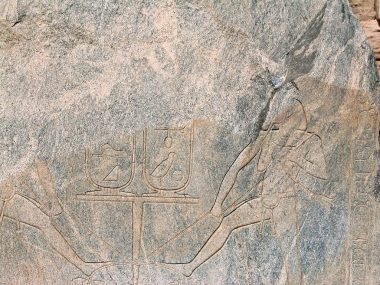 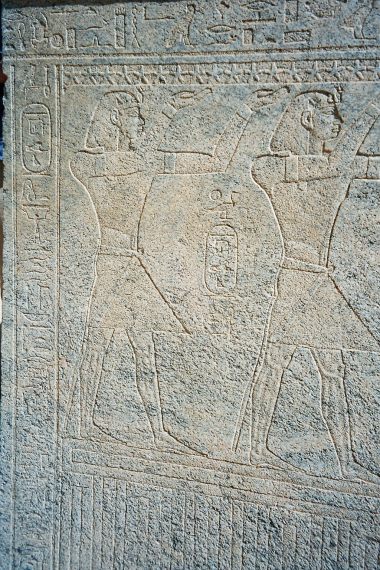 The Djebel Barkal mountain has been confirmed by Thotmes III as the main residence of the god Amon. Its naturel pick (Timothy Kendall researches) was considered as the representation of the royal snake, and the Upper Egypt crown / La montagne du Djebel Barkal a été confirmée par Thotmès III comme la résidence principale du dieu Amon. Son pic naturel (recherches de Timothy Kendall) pouvait être considèré comme la représentation du cobra protecteur et de la couronne de la Haute Egypte.
General view of the Holy mountain and the pyramids built near the Amon's sanctuary at the meroitic period / Vue d'ensemble de la montagne sacrée et des pyramides construites à proximité du sanctuaire d'Amon à l'époque méroitique.
One of the pyramids (meroitic period) built near the Amon's sanctuary / Une des pyramides de l'époque méroitique construite près du sanctuaire d'Amon
Western side of the Holy mountain with a long sand running (about 90 meters) / Coté ouest de la montagne sacrée caractérisé par une longue coulée de sable d'environ 90 mètres
Djebel Barkal pick dominating Karima valley / Pic du Djebel Barkal dominant la plaine de Karima
From the top of the Holy mountain, general view over the ruins of the temples of Amon of Napata and Amon of Thebes / Depuis le sommet de la montagne sacrée, vue sur les ruines des temples d'Amon de Napata, et d'Amon de Thèbes
Hathoric columns belonging to the typhonium (birth house) / Colonnes hathoriques du typhonium (maison de la naissance)
Typhonium hathoric columns and behind, the Djebel Barkal pick / Colonnes Hathoriques du typhonium et en arrière plan, pic du Djebel Barkal
Inside the typhonium, pilaster representing the god Bes considered as the protector of the new-born childs / A l'intérieur du typhonium, pilastre représentant le Dieu Bès considèré comme le protecteur des nouveaux-nés
Inside the typhonium, painting of the king Taharqa and his royal spouse, offering to Amon of Napata, the nou pots / A l'intérieur du typhonium, représentation du roi Taharqa accompagné de sa grande épouse royale faisant offrande à l'Amon de Napata, des pots nou
Base of Amon's boat situated in the Holy sanctuary in the temple of Amon of Napata / Socle de la barque d'Amon situé dans le Saint des Saints du temple d'Amon de Napata
God symbolizing the semataouy (union between the upper and the lower Egypt). On this monument, the Hapy gods are protecting the names of the king Taharqa / Génies symbolisant le semataouy c'est à dire l'union de la Haute et de la Basse Egypte. Sur ce monument, les génies Hapy protègent les cartouches du roi Taharqa
On one of the sides of the base of Amon's boat, bas-relief of the king Taharqa holding up the sky / Sur un des cotés du socle de la barque d'Amon, représentation du roi Taharqa soutenant la voûte céleste
|
|
The Great Temple of Amun of Napata. The current remains date to the reign of the king Piye and adopt the classic plan of an Egyptian sanctuary (pylon, peristyle court, hypostyle rooms and a sanctuary surrounded by lateral rooms). In this temple Reisner discovered in 1920 the stela of Thutmose III dated to 1457 BC. It recounts the history of the foundation of the first Egyptian settlement at Jebel Barkal and mentions a miracle through which Amun reveals himself to be the occupant of the mountain. The text specifies that Amun of Napata at Jebel Barkal gives kingship over the 'Two Countries' (Upper and Lower Egypt) and that the Amun of Thebes gives kingship 'over all the foreign lands'. This assertion, which recognizes the primacy of the Nubian world over the Egyptian is admirable on the part of Thutmose III.
The temple of Amun of Thebes is smaller in size, but reproduces the same architecture as the other sanctuary of Amun.
The temple-speos of the birth is decorated by columns representing the god Bes, a deity that protects the mother and the new-born. On one of the walls a low-relief reproduces the 'holy' mountain, with the god Amun and the goddess Mut. A cobra recalls the rocky outcrop. Taharqa offers the nu pots and the queen makes a libation. It would seem that this representation of the 'holy' mountain was reproduced in the temple of Abu Simbel, on the wall in front of the battle of Kadesh.
The palace of the king Natakamani has been studied since 1973 by a team from la Sapienza (the University of Rome). It is located to the east of the cult centre of Jebel Barkal and dates to the Augustan period. The exterior façade was decorated by a succession of projections and retractions. Square in shape, the palace possessed four entrances and two staircases allowing the access to terraces.
The excavations have unearthed ionic capitals. A gallery-portico gave onto an internal courtyard. On the ground floor, a passage made up of three doorways allowed access to a room divided into three aisles, to an antechamber and an audience hall. A quantity of bread moulds and clay seals have confirmed both the activities of production and distribution that were evidently part of the administrative function of the palace.
The pyramids to the west of the 'pure' mountain. A first group was erected during the Napatan period between 315 and 270 BC, with three kings buried there. The second group dates to the Meroitic period, between 90 and 50 BC, with two kings and one queen buried there. But why were these funerary monuments erected at Jebel Barkal when the official cemeteries were at Nuri and Meroe?
In conclusion, although the remains are less impressive than those of the temple of Karnak in Egypt, the cult centre of Jebel Barkal underlies the religious belief that the god Amun, through his Nubian origin, confirmed his primacy over the whole Nile Valley.
|
|